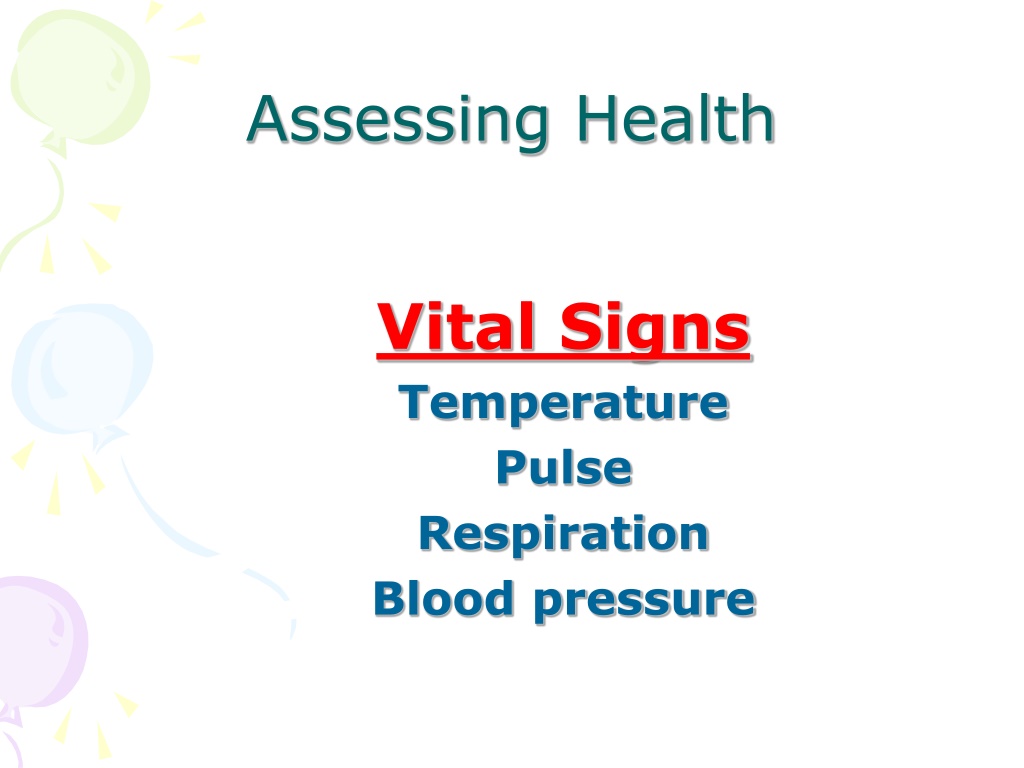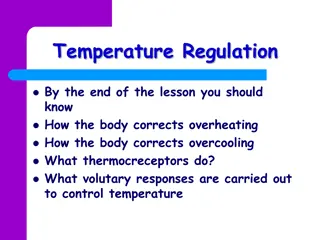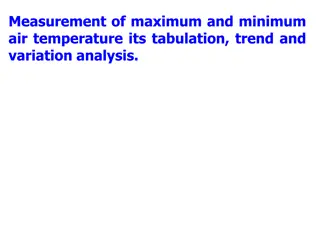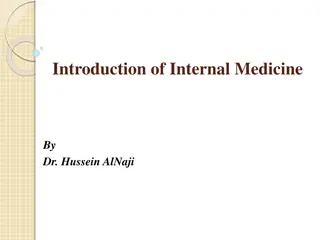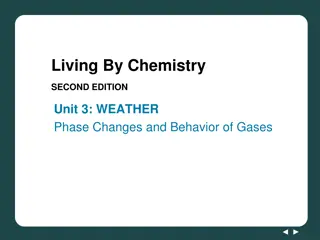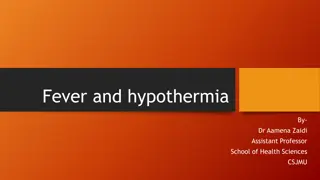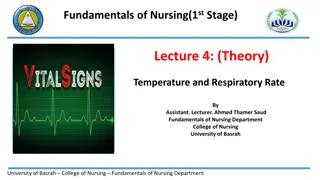Understanding Body Temperature Regulation and Factors Affecting It
Body temperature regulation is a complex process involving the balance of heat production and loss. Factors like age, hormones, stress, and environmental changes can influence body temperature. Heat production is affected by factors such as basal metabolic rate, muscle activity, fever, and sympathetic stimulation. Heat loss occurs through radiation, conduction, convection, and vaporization. The body maintains temperature through sensors, the hypothalamus, and effector systems. Alterations in body temperature can range from pyrexia (fever) to hypothermia. Understanding these mechanisms is crucial for assessing health and vital signs accurately.
Download Presentation

Please find below an Image/Link to download the presentation.
The content on the website is provided AS IS for your information and personal use only. It may not be sold, licensed, or shared on other websites without obtaining consent from the author. Download presentation by click this link. If you encounter any issues during the download, it is possible that the publisher has removed the file from their server.
E N D
Presentation Transcript
Assessing Health Vital Signs Temperature Pulse Respiration Blood pressure
Body Temp Reflects the balance between heat production and heat loss. Core temp: in the deep tissues of the body (abdominal cavity)(36-37.5 C) Surface temp. of the skin
Factors affect heat production Basal Metabolic Rate (rate of energy utilization in the body required to maintain essential activities): in younger persons. Muscle activity: shivering BMR Thyroxine output: (chemical thermo-genesis) (stimulation of heat production through cellular metabolism)
Factors affect heat production Fever: cellular metabolism Epinephrine and sympathetic stimulation
Heat Loss Radiation: b/w 2 surfaces without contact Conduction: from higher to lower temp (swimming in cold water) Convection: dispersion of heat by air currents. Vaporization: evaporation from respiratory tract.
Regulation of body temp Sensors (detect heat/ cold & send signals to reduce temp or increase heat production) Integrator in the hypothalamus Effector system to adjust production and loss of heat Sensors detect cold vasoconstriction, shivering Sensors detect warmth sweating, peripheral vasodilatation
Factors affecting body temp Age (thermoregulation control) (extreme age groups) Diurnal variation (early morning- sleep) Exercise: increase temp
Factors affecting body temp Hormones (progesterone temp) Stress production of adrenaline Environment changes.
Alterations in body temp Average (36-38 C) Pyrexia (hyperthermia) (38-41 C) = Fever= Febrile. Hyperpyrexia (more than 41 C) Hypothermia (below 36 C)
Common types of fever Intermittent: alteration of temp on regular intervals Remittent: wide range of temp fluctuation than 2 C/24 hrs. Relapsing: short febrile periods of a few days. Constant:always remains above normal Fever spike: rapid rise of temp.
S + S OF HYPERTHERMIA HR Resp rate Shivering Cold skin, pallor Photosensitivity thirst Mild to severe dehydration
Nursing Care of thermia Monitor V/S Assess skin: color and temp. WBC s Remove excessive clothes/blankets Adequate fluids and nutrition I & O Antipyretics as prescribed Tepid sponges
Hypothermia Excessive heat loss In adequate heat production Impaired hypothalamic control (regulation)
Clinical S + S of thermia temp., pulse and resp. Severe shivering Chills Pale, cool. Hypotension urinary output Drowsiness progressing to coma
Nursing Care of thermia Warm environment Dry clothes Warm IV fluids Warm pads (sponges)
Assessing body temp Oral (food, fluids, smoking, exercise) Rectal (very accurate) (3.5 cm) (C/I in MI, diarrhea, rectal surgery or diseases) Axillary (newborn) (inaccurate in fever) Tympanic (membrane injury)
Types of thermometers Long tip :oral Rounded : rectal/ Axillary Electronic Chemical disposable Infrared Skin tape
Temp scales C = (Fahrenheit 32) x 5/9 F = (Celsius x 9/5)+ 32
Oral temperature Accessible and convenient Easily break down Inaccurate if hot or cold fluids or smoke ingestion Injury post oral surgery
Rectal temp Reliable and the most accurate measurement Inconvenient and unpleasant Difficult to those clients cannot turn Could injure rectum post rectal injury Presence of stool may interfere accuracy
Axillary temp Safe and non invasive Must left long period of time
Tympanic temp Accessible Reflects core temp Very fast Uncomfortable and may be invasive to membrane Varied repeated measures Cerumen may affect readings
General guidelines in temp assessment Explain procedure Hand washing Privacy Sim s or lateral position Protective sheath or lubricant 2-3 min for an oral (either side of frenulum) or rectal temp (deep breath and 3.5 cm against rectal wall) 6-10 min in axillary (bulb in the center of axilla) temp Pull pinna slightly upward and backward, anteriorly to ear drum in tympanic temp. Wiping glass thermometer Read temp Wash thermometer Documentation
General guidelines in temp assessment Use axillary temp in infants Tympanic or axillary routs are preferable in children
